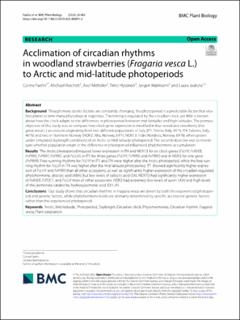| dc.description.abstract | Background Though many abiotic factors are constantly changing, the photoperiod is a predictable factor that enables plants to time many physiological responses. This timing is regulated by the circadian clock, yet little is known about how the clock adapts to the differences in photoperiod between mid-latitudes and high latitudes. The primary objective of this study was to compare how clock gene expression is modified in four woodland strawberry (Fragaria vesca L.) accessions originating from two different populations in Italy (IT1: Tenno, Italy, 45°N, IT4: Salorno, Italy, 46°N) and two in Northern Norway (NOR2: Alta, Norway, 69°N, NOR13: Indre Nordnes, Norway 69°N) when grown under simulated daylength conditions of an Arctic or mid-latitude photoperiod. The second objective was to investigate whether population origin or the difference in photoperiod influenced phytohormone accumulation. Results The Arctic photoperiod induced lower expression in IT4 and NOR13 for six clock genes (FvLHY, FvRVE8, FvPRR9, FvPRR7, FvPRR5, and FvLUX), in IT1 for three genes (FvLHY, FvPRR9, and FvPRR5) and in NOR2 for one gene (FvPRR9). Free-running rhythms for FvLHY in IT1 and IT4 were higher after the Arctic photoperiod, while the free-running rhythm for FvLUX in IT4 was higher after the mid-latitude photoperiod. IT1 showed significantly higher expression of FvLHY and FvPRR9 than all other accessions, as well as significantly higher expression of the circadian regulated phytohormone, abscisic acid (ABA), but low levels of salicylic acid (SA). NOR13 had significantly higher expression of FvRVE8, FvTOC1, and FvLUX than all other accessions. NOR2 had extremely low levels of auxin (IAA) and high levels of the jasmonate catabolite, hydroxyjasmonic acid (OH-JA). Conclusions Our study shows that circadian rhythms in Fragaria vesca are driven by both the experienced photoperiod and genetic factors, while phytohormone levels are primarily determined by specific accessions’ genetic factors rather than the experienced photoperiod. Keywords Arctic, Mid-latitude, Photoperiod, Daylength, Circadian clock, Phytohormones, Circadian rhythm, Fragaria vesca, Plant adaptation | en_US |

